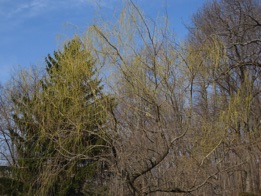* * *
* * *
Accounting for Spring 4/2/2011
The branches of the weeping willow kindle to a golden glow so gradually that I cannot say when it began. Something coming is already here. The willow’s gold threads call to mind Robert Frost’s observation that "Nature’s first green is gold" (see "Nothing Gold Can Stay").


The same surreptitious engolding comes simultaneously to the plumage of the goldfinches at the feeder. I suspect collusion: the finches, fluttering through the willow cloud in the first light, stain it with that color seeping through their winter drab. In autumn, the first dusting of snow arrives with the Slate Grey Dark-Eyed Juncos, who carry it south with them hidden in the white feathers at the edges of their dark tails.
I’ve tried to keep track of the signs of spring in my journal this year: Heard a peeper on a rainy night in early March (the 10th). After being away for a long weekend, I heard them in full swing on March 15th. On March 17th, walking along the ridge, I heard a chorus of frogs in the spring pool down the north slope, at the wood’s edge, near the sheep farm. The next day, the mildest day yet, in the high 60’s, as I was taking this picture of the goldfinch at the feeder, I saw and heard for the first time this year the phoebe, who reminded me that twelve springs ago when I came to Hillside for the first time, it was he who called to me and said, You belong here.

Jani and I noticed this year’s skunk cabbages for the first time as we walked along a tributary of Honey Brook on March 19th. Some of them were already turning green, though most still showed only the first tent-like purple leaf, the spathe, enclosing its spadix like some sacred sculpture in a grotto. I’m sure we might have seen them sooner had we tried. It’s all about paying attention. In fact, just as Titania’s Bower is not a place but a way of seeing, so the beginning of Spring is not a moment in time but a story, an accounting.

Today, the orchestra is merely tuning up. We took our customary walk again, crossing Honey Brook and its tributaries six times or more in one of our longer circuits from Crusher Road to the Watershed Pond and back. Though the brown compost of the winter marsh still predominates, the skunk cabbages gather now in larger numbers, unfurling their green banners in demand of longer light. Two foxes, one near, one far, barked in the gloaming down the north side of the ridge as I sat at High Point after sunset, after the last measure of the robins’ evensong. And later, when I stripped to take a shower, I found a deer tick stuck to my ribs, the surest sign yet that spring is here.
This morning, as I walked down the lane, finch gossip filled the treetops invisibly, as if the buds themselves were tintinnabulating. A red-bellied woodpecker chortled restlessly from trunk to trunk on the wooded hillside, and a cardinal let his spring chant unwind, though neither his song nor any other has as yet the full-blown, mindless insistence that will come to them all as they sing of love and territory in the coming weeks.